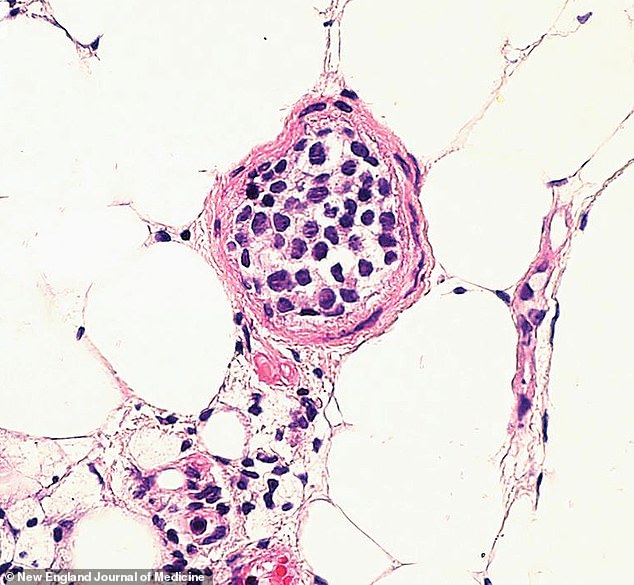Varicose veins could be a sign of CANCER, doctors warn – after treating 53-year-old woman with aggressive lymphoma
- A woman in China with varicose veins and fever was diagnosed with cancer
- Doctors warned that vague symptoms can make lymphoma difficult to diagnose
- READ MORE: Life-Saving Cancer Therapy May CAUSE Cancer Itself, FDA Warns
Doctors warn that varicose veins can be a commonly missed sign of cancer such as lymphoma.
A 53-year-old woman in China went to her doctor after three months of worsening varicose veins covering her chest and abdomen, and fever.
Doctors performed a deep skin biopsy, which revealed intravascular large B-cell lymphoma, a rare and aggressive form of cancer that affects small blood vessels.
The team warned that vague symptoms like these could make lymphoma, which affects nearly 90,000 Americans annually, more difficult to diagnose.
The patient (pictured here) had varicose veins covering her chest and abdomen, as well as a persistent fever

A deep skin biopsy revealed intravascular large B-cell lymphoma, a rare and aggressive form of cancer that attacks small blood vessels
Varicose veins are twisted, swollen or enlarged veins just under the skin. They are most commonly found in the legs, although they can occur in any vein close to the surface of the skin. They are usually dark purple or blue.
Weak or damaged heart valves can lead to varicose veins. This is because the arteries need to transport blood from the heart to the rest of the body.
When the valves are damaged, they have a harder time pumping blood back to the heart, leading to blood pooling in the veins.
Although they may be painless, varicose veins can cause pain, burning, and throbbing, especially after sitting or standing for long periods of time.
Veins become weak or damaged due to age, obesity, pregnancy or an inactive lifestyle.
B-cell lymphoma is the most common type of lymphoma. It starts in the B cells, which make antibodies to protect you from viruses.
Intravascular B-cell lymphoma produces cancer cells in the lumens, the passageway in the small blood vessels through which blood flows.
According to the American Cancer Society, since this cancer affects the small blood vessels, it can cause blood to pool in the veins. This can weaken them and lead to varicose veins.
Symptoms include fever, night sweats, weight loss, fatigue, stomach pain, rash, itchy skin and bloating, all of which are often attributed to other conditions.
“The disease is difficult to diagnose due to its non-specific symptoms and signs,” the medical team wrote.
'In this case, the patient's isolated skin condition was consistent with the cutaneous (skin) subtype of intravascular large B-cell lymphoma.'
The patient received chemotherapy. As of her six-month follow-up visit, she showed no signs of the disease.
Varicose veins have been observed in other patients with intravascular lymphoma, but not as severe as in the patient in China.
The case study was published in the New England Journal of Medicine.
